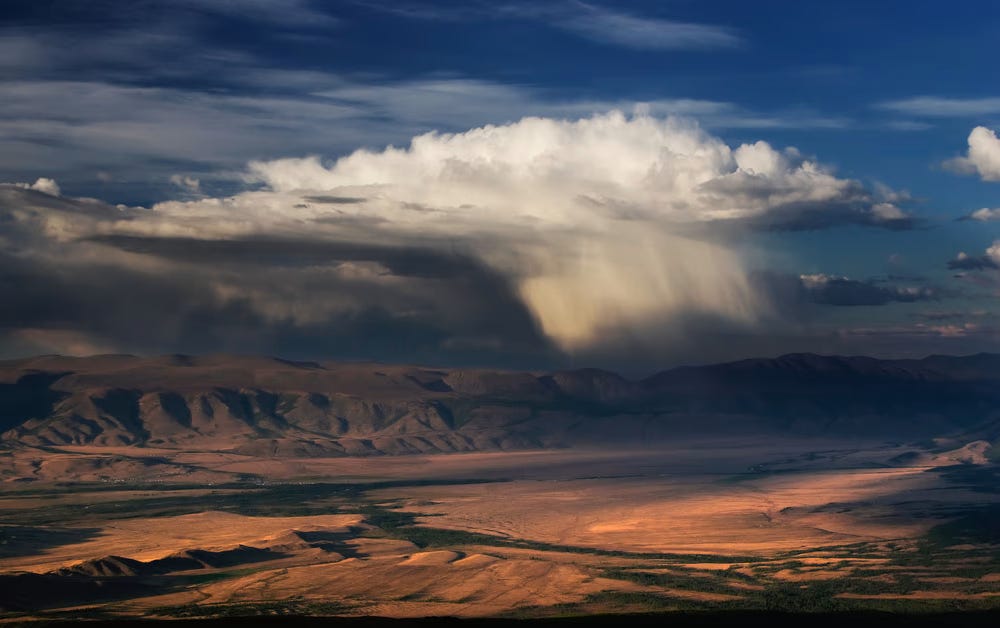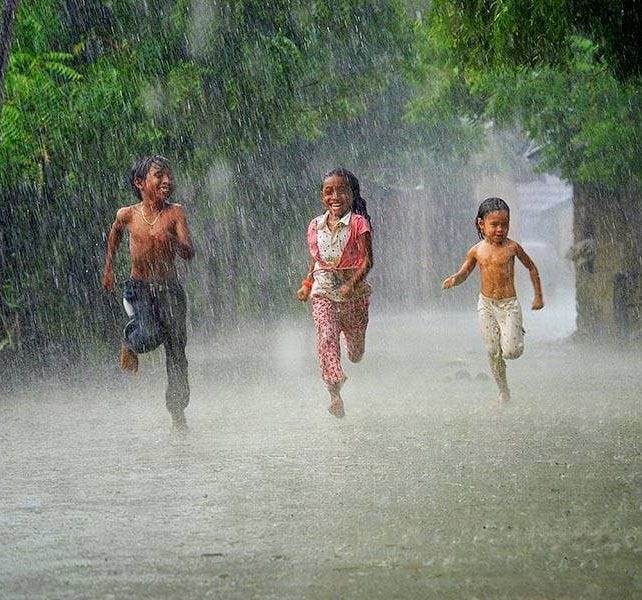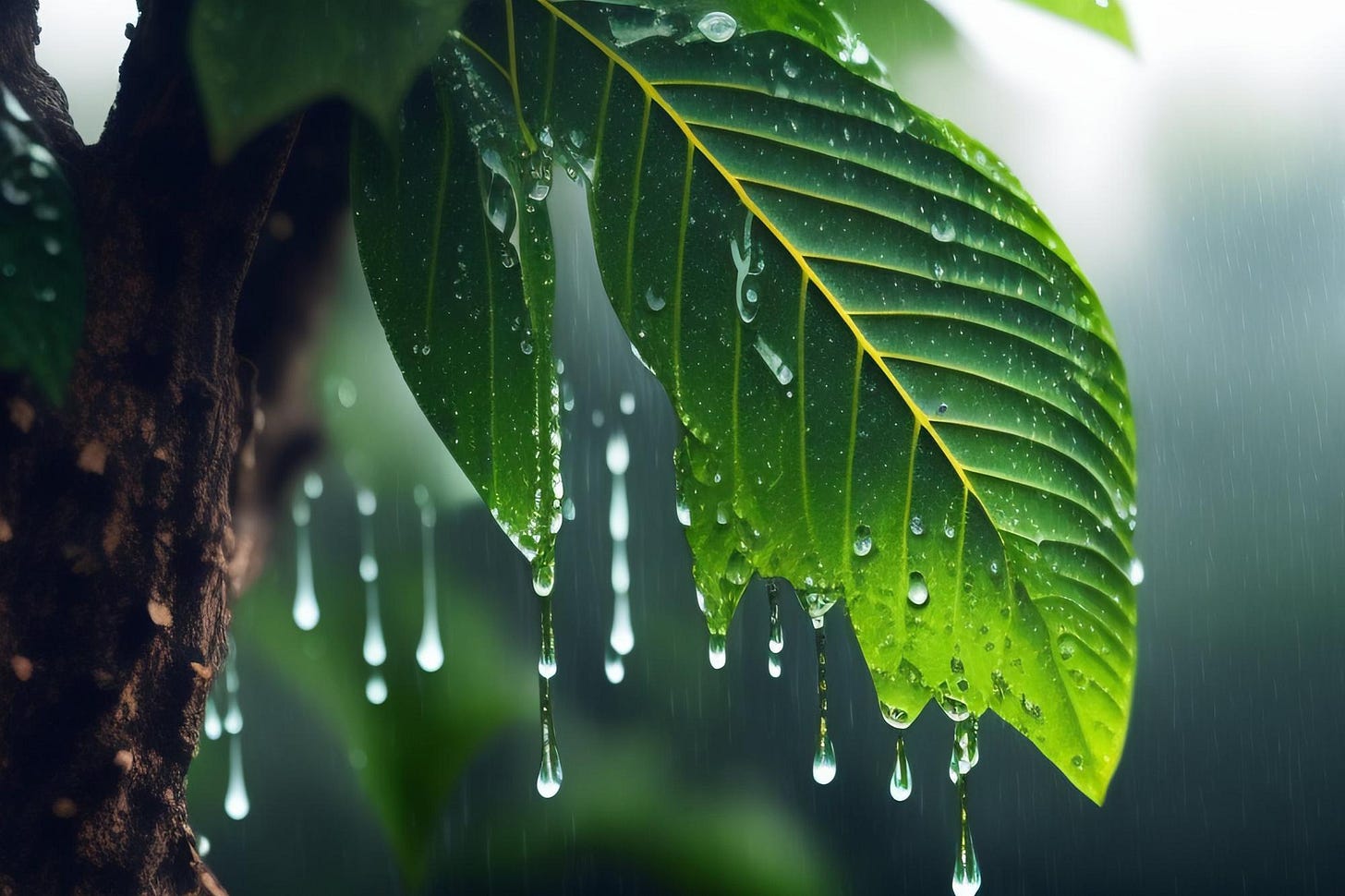Reimagining Rain
10/03/24 – Some thoughts on our relationship with rain
Hello everyone:
In the wake of the catastrophic and historic flooding from Hurricane Helene, I’m offering a reworked version of an essay I wrote in August last year after a very wet summer. The inspiration then was meditative - thinking about rain in the Anthropocene from the comfort of a warm, dry house - but this week the spark is more about facing up to the horrifying consequences of living in a climate that is hotter, more turbulent, and more full of rain. Still, though, the writing here is mostly meditative, which is no balm for everyone suffering in Helene’s path, from FL to NC (or in Nepal and elsewhere). Most of them are still without power anyway, and unlikely to be scrolling Substack for long essays that ruminate poetically on rain. So this is for the rest of us, warm and dry for the moment, but living in a world that has much more to unleash than we are currently prepared for.
Ways to help: World Central Kitchen, Direct Relief, United Way of North Carolina, and United Way of Florida.
’s latest post offers several ways to help the folks in Asheville, NC, and elsewhere. Please add others you recommend in the Comments.As always, please remember to scroll past the end of the essay to read some curated Anthropocene news.
Now on to this week’s writing:
For a sense of why a mountain town like Asheville, NC, is underwater, the latest post from
is a good place to start, and within that post there are no more important lines than these: “warm air holds more water vapor than cold,” and there is “about 7% more water vapor in saturated air for every 1°C of ocean warming.” I’m reminded of a guy I worked with who could get a dump truck screaming and into 4th gear before he’d even left the barn. The Gulf is extraordinarily warm, so Helene revved up, loaded up, and was able to surge hundreds of miles inland, flooding every human and ecological community in its path, before dumping nearly four feet of rain across the peaks of the Blue Ridge.The U.S. has had as many Category 4 and 5 hurricanes make landfall in the last eight years as we did in the previous fifty seven years.
But rain-as-reckoning is a global story. I’ll give McKibben one last paragraph about the scale of what a hotter atmosphere is up to before moving on to my gentler essay on rain. I’ll put a few phrases in bold so you understand that this is happening now:
Were it happening just in one place, a compassionate world could figure out how to offer effective relief. But it’s happening in so many places. The same day that Helene slammed into the Gulf, Hurricane John crashed into the Mexican state of Guerrero, dropping nearly 40 inches of rain and causing deadly and devastating floods in many places including Acapulco, which is still a shambles from Hurricane Otis last year. In Nepal this afternoon at least 148 people are dead and many still missing in the Kathmandu Valley. Just this month, as one comprehensive twitter thread documented, we’ve seen massive flooding in Turkey, the Philippines, Saudi Arabia, Spain, Marseilles, Milan, India, Wales, Guatemala, Morocco, Algeria, Vietnam, Croatia, Nigeria, Thailand, Greece, Romania, Poland, the Czech Republic, Austria, with the Danube hitting new heights across Central Europe. It is hard to open social media without seeing cellphone videos from the cars-washing-down-steep-streets genre; everywhere the flows are muddy-brown, and swirling with power.
Swirling with power, indeed. No place is climate-safe on a planet on which we’ve converted two-thirds of its grasslands and a third of its forests for farming and grazing, and on which we’ve burned tens of millions of years of stored fossil energy in mere decades. The atmosphere, the oceans, and the continents are all transformed. Maybe your community, like mine here in coastal Maine, is doing okay in this moment. Who knows what next year might bring? Before Helene, Asheville was being touted as a “climate haven” by real estate agents.
But again, it’s rain in all its guises, ancient and Anthropocene, that’s on my mind.
Not in the way it addled the minds of the humans on Venus in Ray Bradbury’s short story “The Long Rain,” though. The rhythm of rain on my head isn’t driving me insane. No, for someone like me (who has never had a house swept away by floods) the sound of rain is always welcome and beautiful, from the patter of the first fat drops in the dust of a hot July day to the roar of a downpour sweeping through forest leaves like the sea.
Rain asks for rumination, so I’m ruminating.
That Bradbury story starts with this paragraph, one that folks in flood-ravaged North Carolina can probably relate to:
The rain continued. It was a hard rain, a perpetual rain, a sweating and steaming rain; it was a mizzle, a downpour, a fountain, a whipping at the eyes, an undertow at the ankles; it was a rain to drown all rains and the memory of rains. It came by the pound and the ton, it hacked at the jungle and cut the trees like scissors and shaved the grass and tunneled the soil and molted the bushes. It shrank men’s hands into the hands of wrinkled apes; it rained a solid glassy rain, and it never stopped.
I’m going to venture outward into the rain here, which also means venturing upward and downward, and occasionally inward. And in the end I’ll circle back to those “hands of wrinkled apes.” My goal with this writing was to learn more about rain, to enrich the stories we tell about it, and to articulate it to you in a way that might help you reimagine your relationship with this damp revelator.
Rain, after all, is where we literally understand – to stand under is to receive what falls to us – and connect to a taste of what is wild and real and home.
Some of these notions you know already, I’m sure, but hopefully you’ll find something to think about.
***
Rain doesn’t live in the sky:
It lives in the ocean and lakes and sends a little of itself to rise with the wind to greet the Sun. It lives in the soil and commutes to the atmosphere through plants. Water begets water, soil is the womb, and vegetation is the midwife, as Millan Millan and Rob Lewis reminded us. The formation of rain on high, and its descent, are only part of a journey that begins at our feet. Or really, it neither begins nor ends. Rain breathes, and breathes the world into being.
Mostly it sleeps: in lakes and mountain glaciers for decades, in shallow groundwater for a couple centuries, in the ocean for millennia, in deep groundwater for 10,000 years, and in Antarctic ice for tens or hundreds of thousands of years. Its time in the atmosphere, in contrast, is a lark that lasts only nine days.
Rain has a heart:
Water vapor won’t condense into a droplet unless it has something to condense on: a nucleus. Without nuclei, there would be no clouds. These nuclei have lifted off the ground like the vapor pulled upward by the Sun, and once they meet, and the cloud droplet swells from its initial .02 mm to raindrop size (2.0 mm), they fall together. It is tempting to say every raindrop has a heart, but raindrops burst against each other in the chaos of falling and so some of what arrives on your window, lawn, or tongue may not have a crunchy core.
What works as nuclei? Bacteria and other microbes by the trillions, desert dust and clay particles by the ton, vast quantities of sea salts, sulfates from volcanic eruptions, mushroom spores, conifer pollen, soot from wildfires, and dimethylsulfide produced by healthy coral reefs, to name some of the usual suspects.
And then, in our recent confusion of what constitutes a meaningful life, we added some other contenders: burnt fuel particulates from aircraft, ships, and industry, antibiotic-laced dust from cattle feedlots, and many more, including PFAS chemicals, some of which are already known to work as ice nuclei in higher clouds.
PFAS chemistry is a horror we’ve added to the sky, and as the rain cleans the air it brings the horrors home to roost. It is a brutal Anthropocene fact that rain and snow around the globe, even in the most remote areas, carry these “forever” chemicals at levels that make it unsafe to drink.
And a small irony – or an echo, really – of that horror is that the heart of the waterproof raincoats we wear in the rain are usually infused with the same chemicals.

Rain as jellyfish:
It has been some years now, but as a young man I had a great fondness for sprawling on mountaintops and watching a scattering of flat-bottomed summer clouds dangling rain as they sailed at eye level across the forests and waters of this beautiful world. The illusion of being underwater watching vast jellyfish is just one more joy in the abundance of joys inherent in resting at altitude.
Sometimes the tentacles don’t reach the ground. Virga (from the Latin for “branch” or “streak”) is the term for the rain that dangles but doesn’t make it home. The raindrops are unmade as they’re eaten by dry air. “Torture by tantalizing, hope without fulfillment,” wrote Ed Abbey in Desert Solitaire.
Once, in later years, as I walked unmarked hunters’ trails in Luberon Regional Natural Park in southern France, on a very hot dry day, a few fat drops hit the dust around me. And that was it.
But those few drops reminded me suddenly of perhaps the most elegant fossil I’ve ever seen. In the natural history museum at Amherst College is a desk-sized slab of Jurassic mud recording a two-hundred-million-year-old moment of rain much like mine in the Luberon. A few fat drops fell and were then captured, like a photograph in stone.
Or rather, the impressions were captured. Those raindrops are still around, somewhere.

Rain is ancient, yes. But it is equally new:
Maybe you’ve heard that the molecules of water dripping off your nose may have once slid down the spine of a triceratops. Water molecules, like matter, are neither created nor destroyed. They share an existence of constant transformation.
Yet the pattern of rain clouds jellyfishing through the atmosphere at this moment is likely unique in world history. There’s so much flux and subtlety in clouds, a dynamism that befuddles forecasting algorithms and entrances skywatchers. There’s an analogy for this in the ever-changing texture of the surface of the ocean. Both are familiar and impossibly strange, fingerprints that form and vanish every instant. And both are analogies for the mutability of life itself, the infinite rhythm we are part of, a rhythm heard in the patter of rain on the roof.
Rain is a reminder of the unity of all things:
Is there any other species that thinks of raindrops as individuals? It’s a conceit that seems particularly human to me. There is only rain. Or, better yet, there is only water. Rain is merely water returning to the harbor.
As much as we talk about the importance of the web of relationships that underpin the natural world, I think we’re still mostly thinking about a relationship between things. But species, organisms, organs, traits, genes, cells are not things; they’re nodes in the relationships. Energy passes through Earth systems and networks of life, nutrients migrate along magnetic fields in the shape of birds, births and deaths are both transient wombs.
Because you and I and the other eight billion weird naked primates have a consciousness built mostly on narrative, we itemize the world and dramatize the relationship between items. As I often note here, very little actually sets us apart from other life, but one thing that does is our capacity and willingness to reimagine the world.
This isn’t necessarily bad or destructive – witness the pre-Anthropocene million years of small-scale creative human activity – but the stories we tell can create unity and empathy or they can generate difference and indifference. How we think of rain is as good a barometer as any for assessing what kind of stories we’re telling.
We have already reimagined rain:
From the gods’ tears to the blessing on the crops, rain is now often reduced to an annoyance that plagues a species grown soft amid climate-controlled rooms. It’s the “resource” we squander and squabble over. And now, increasingly, it’s the unpredictable force that pushes and pulls at civilization, shaking us awake, withholding its blessing with one hand while flood-punishing us with the other.
Cynthia Barnett summarizes this new paradigm nicely in her book, Rain: A Cultural and Natural History:
Modern living, with its reservoirs, irrigated agriculture, and invisible water pipes that run for millions of miles underground, dulls us to our fragile dependence on rain. El Niño – named for the Christ Child in the 1600s by the South American fishermen who first observed the warming that tends to come around Christmastime – is one dramatic reminder. Human-caused climate change is proving another.
The inequality of rain in a world of inequality:
A warmer atmosphere holds more moisture and acts with more turbulence. The new map of intensified floods and hotter, longer droughts is an Anthropocene inequality we’ll have to suffer (especially in poor and neglected communities) as we fight to rein in emissions and restore the green world in order to keep it from getting worse.
That inequality is rooted in the inequality that drives so much of what ails the modern human experiment – the institutionalized varieties of selfishness we label colonial, corporate, capitalist, exploitive, racist, patriarchal, and nationalist – and is pushing our presence on this planet beyond the safe boundaries of its ecological and geophysical systems.
One of the more terrifying sentences I can write in this Field Guide is this: Ecological survival in the Anthropocene is more and more a function of good governance.
Which is why addressing our destruction of the natural world and the scourge of waste emissions that heat the atmosphere requires seemingly unrelated battles like reforming corporate tax systems, fossil fuel subsidies, and energy investments at the big banks.
As we’ve made deserts we’ve unmade rain:
The loss of forests has also meant the loss of moisture. To a large degree, it’s our food that’s been doing the erasing. Desert has followed the plow and cow since the dawn of what we call civilization. Biodiverse habitats are replaced by monocultures as soil bakes and washes away.
Where trees and grasslands are erased, so is water. But the good news is that where carbon is sequestered, so is water.
If we want a more stable global water cycle, it’s not enough to rein in emissions and draw down CO2 and methane; we have to revive and restore forests as well. And we each have a role we can play here, whether helping to protect intact and semi-intact ecosystems or restore degraded ones. Half of the globe has been converted to human use, which means there’s an enormous amount of land that can be restored. As
wrote in a Resilience article,once I began learning about the biological, water-based aspects of climate, my view of climate and the natural world transformed. Muir’s oft-quoted observation, “when we try to pick out anything by itself, we find it hitched to everything else in the universe” suddenly came alive. I discovered, over and over, that when I grabbed the thread called “climate” it was hitched to everything on Earth, part of something very much alive and capable of recovery. And with that my doom, not my worry and concern and grief, but that powerless sense of doom vanished. I stood on different ground, having come to know its power.
The more you help to protect and restore green landscapes, the more you become a rain maker.

Rain as bridge:
From land to sky and sky to self, sure, but also self to the cyclical, self to the beautiful self-governing world. What ignores us saves us, I’ve always thought. To me, it’s not a god that cares for us that provides salvation; it’s the vast and vibrant green/blue existence into which we’re woven invisibly but inseparably. Take a long walk in the rain while breathing in all that damp glory, and when you return I dare you to tell me you didn’t feel at least a little of the safe harbor that rain finds when it falls.
“The hands of wrinkled apes”:
During that walk in the rain, when you notice your fingertips turning into prunes, know that you’re gazing back a few million years into our early primate history. Those ancestors lived in a particularly wet era in Earth history, and research suggests that our fingers and toes wrinkle not merely because they’re wet, but because the wrinkles give us a better grip on wet surfaces. The physiological response that changes the shape of our fingers is autonomic, like breathing. It’s built into our deepest selves. That’s how much we coevolved with rain.
Rain is endless:
These notes a just a few drops in the ocean. Rain’s place in our lives is a torrent of connections. There are books to be written about rain, what it says about the world, and how we understand it. Our lives and our cycles are woven into those of rain. There are endless quotations from poems and songs, billions of anecdotes from billions of people, and a world of ecological meanings to be teased out and connected to it all. Stories and stories of rain.
Like how for some orchids, rain is sex, or how European swifts that remain aloft for years at a time bathe on the wing in the rain, how Seattle isn’t really very rainy, or how rain may have cost Al Gore the 2000 election. The metaphors are endless: rain as the blues, rain as joy, rain as purge, as loss, as collective action, as lifeblood, as blessing and gift and nourishment.
Despite all the suffering across the globe in this very moment caused by rain falling from an Anthropocene sky, I’ll leave you with thoughts of rain-as-nourishment and our obligation to maintain a world to be nourished by it. Here’s a lovely piece by
on rain, from his :I am grateful for the soft pitter-patter of rain that breaks a dry spell. Each drop is a gift from the skies that washes away the stress of dryness. We had a drought this spring… When the rains finally come, it is such a relief for me and the plants. We are both delighted. They respond with lush new growth. I respond with gratitude and appreciation… The rain enters the soil and an ancient alchemy nourishes the plants. My spirits rise as fast as the growing tip of a tomato plant in July. Life is feeding on life in the soil, mutualism unbound, the way of the world. I want to enter into this mutual relationship, play my part, and learn to see and engage proactively.

Oh, one more thing. If you’re looking for the best rain gauge around, I’d recommend the Stratus. It’s not ornamental, but it’s tough and accurate, and it’s the official rain gauge for NOAA. I love mine. Here’s a review.
Thanks for sticking with me.
In other Anthropocene news:
From
at his Climate Water Project newsletter, a project to help restore the rains to the Iberian Peninsula. Lo, like Rob Lewis, learned from Millan Millan about the essential links between soil, vegetation, and precipitation - Water begets water, soil is the womb, vegetation is the midwife - and in Millan’s honor is beginning to build a coalition to help bring the rains back to Spain and Portugal. Check it out.From the Potsdam Institute for Climate Impact Research, climate change may be the largest driver of biodiversity loss by 2050. The history of the Anthropocene was until the mid-20th century one primarily of the decimation of nature through conversion of land and ocean by brute force and population growth. But climate change has been rapidly overtaking these other human forces in terms of altering the conditions for life on Earth. What makes this report so important is that a) we’re looking at an acceleration of biodiversity loss from a force that is harder to stop than a bulldozer or a plow, and b) it’s the final proof, if we needed it, that the climate and biodiversity crises are the same crisis.
From Heatmap and Rewiring America, an excellent how-to special report, “Decarbonize Your Life.” While the heavy lifting in reducing human impacts on the atmosphere must be done by industry and government policy, bottom-up behavioral changes are necessary as well. The more of us who can make the changes now, the more those changes become affordable for everyone else. The report lays out in detail the How and Why of getting an EV, switching to clean power for the home, making your home more energy efficient, electrifying your appliances, using more clean transportation, cleaning up our diet, and helping to shift our communities in these directions too.
From
and Chasing Nature, a vote amid election season for the meditative practice of sitting in the woods and watching leaves fall. All those leaves knocking on the door of the forest floor and offering solutions to the world’s problems…From Anthropocene, an excellent article on the potential of both forms of geothermal energy. Geothermal is something of a dark horse in the race for a global renewable energy grid, but may end up being a significant part of the solution. The energy is as reliable as fossil fuels, can provide heat to communities as well as energy, and has a much smaller footprint than solar or wind. And it can conceivably be developed anywhere, since the source is as ubiquitous as solar: the heat beneath our feet.
From the Verge, a new report from the International Energy Agency says, optimistically, that it’s still possible to triple renewable energy output by the end of the decade, as 200 nations pledged to do in Dubai last December. But the scale of the task is daunting, including building or updating 15 million miles (25 million km) of electrical grid lines.
From Yale e360, the Navajo are using traditional methods to restore watersheds and reestablish some food sovereignty.
From the Revelator, a long and sordid tale of Egypt’s authoritarian government cutting down Cairo’s trees and razing its greenspaces, even while acknowledging the need to increase tree cover and parks in a time of rapid warming.
From
, “How Poison is Saving Millions of Seabirds,” an overview of the good news in rewilding islands around the world by killing off the invasive rats, mice, and other species colonizers introduced to them long ago. When the invaders are gone, the seabirds and other native species rebound beautifully.





Jason, I’m in Black Mountain working in the trenches. 80 households stranded on High Rock Acres where I live.. I am in a leadership role during the crisis. I am simply keeping notes to write the story later. I can, however, relay anything to you for your column. Many, many stories.
Capable hikers live here. We have partially rebuilt the road. Everyone is alive. Mental health for most - ok.
I am working the story with a potential NYTimes editor. But the bigger story should live on your Substack:: how do we live forward (at least from my humble perspective.)
I have cell at home on a spotty basis. But can hike to a spot. You can tell the story better. Every time I pick up my pencil in the evening, the tears flow instead of the words.
I am haunted by the images from western NC of whole villages washing away. I was truly stunned by this as I had thought that the mature geomorphology of the Appalachians would make them a stable place and, not knowing much about it, had supposed that the area would be a place to avoid the worst ravages of climate change that are suffered at lower elevations. Now I am thinking they must have removed too many trees(?) rendering the slopes unstable, and/or simply that too many houses were built in the river valleys above some estimate of the worst flood but not really above the worst flood.
Thanks for this educational essay, beautifully written. You let me down carefully on the painful truths that I wish I didn't need to know but I do, cushioned by all the other interesting information around them.